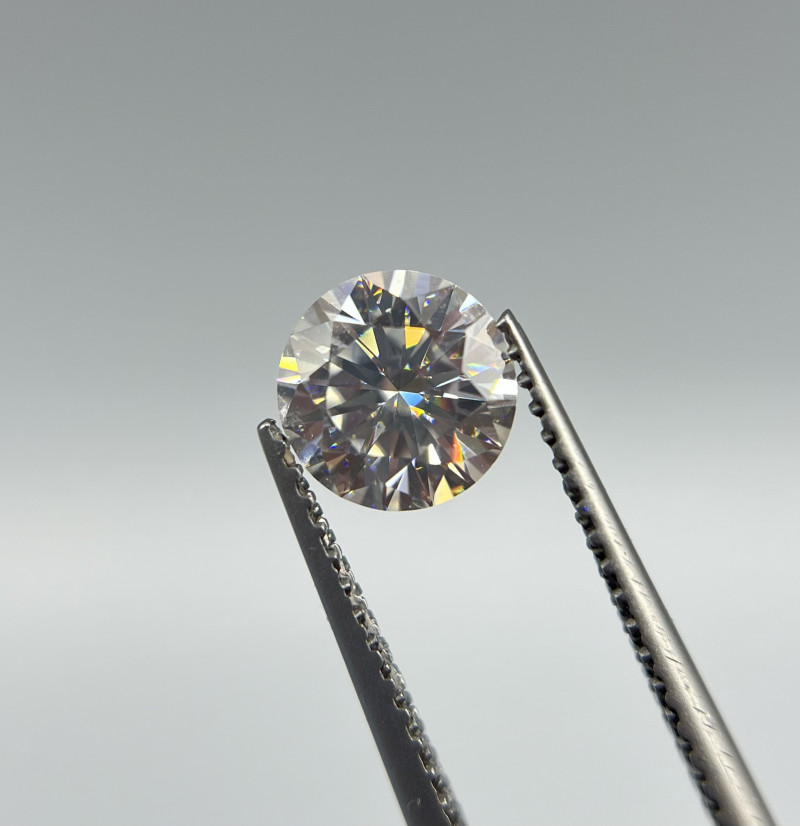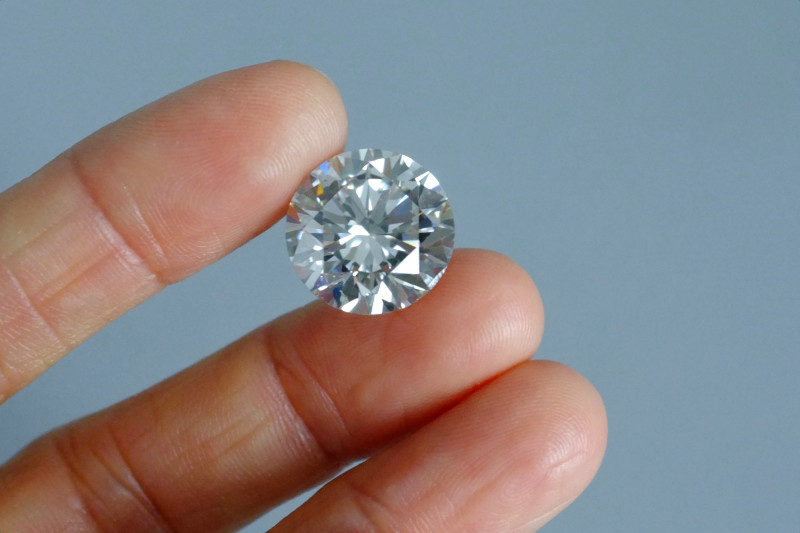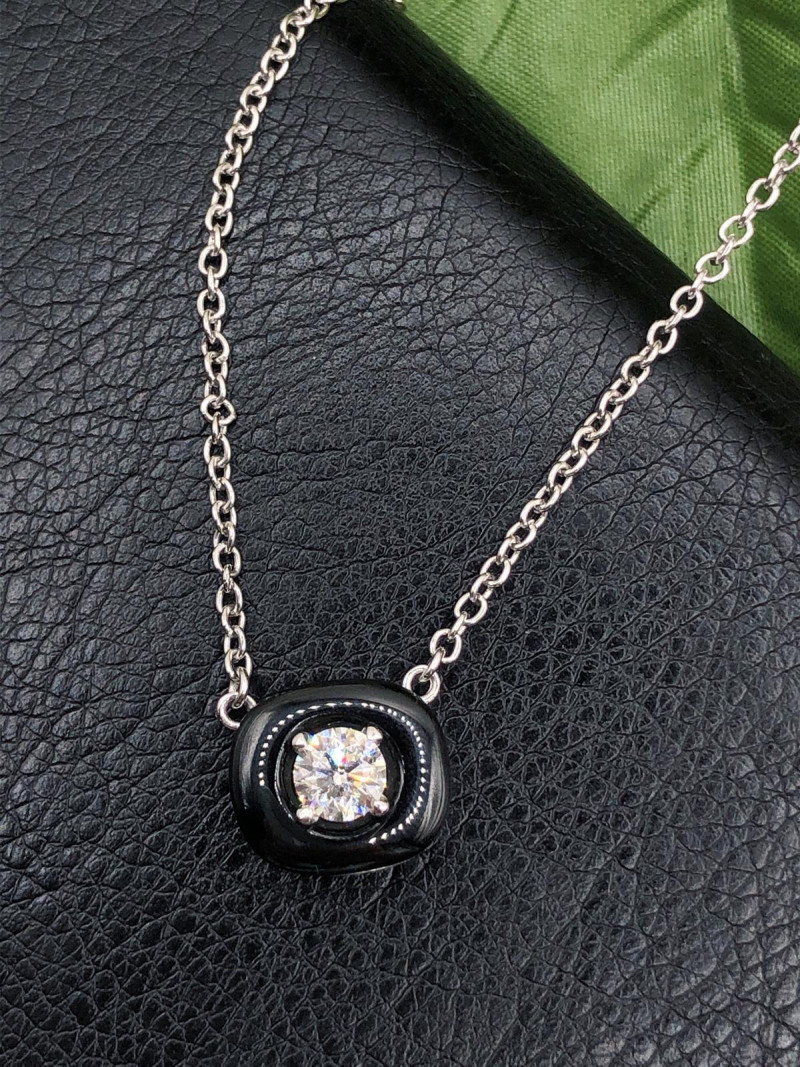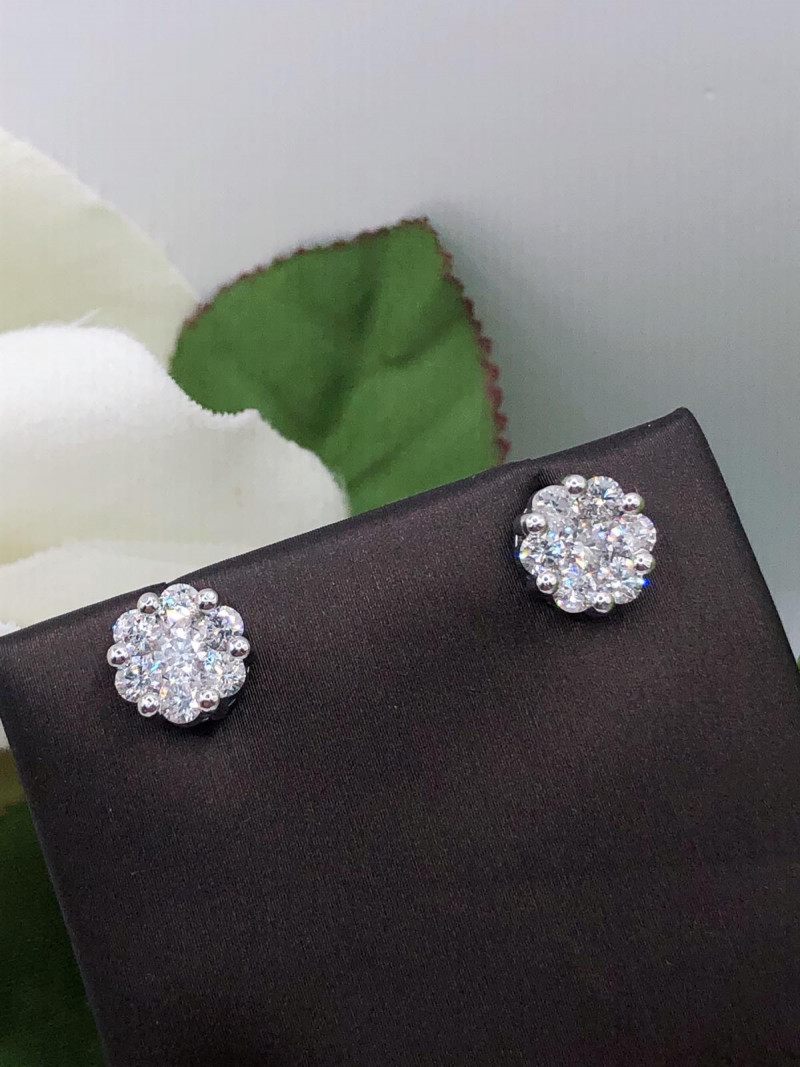
Wat is een Moissanite Diamant? Waarde, Eigenschappen, Voor- en Nadelen
 Moissanite is een kleurloze, transparante edelsteen die vaak wordt gebruikt als alternatief voor diamant. Om deze reden wordt de edelsteen soms "moissanite diamant" genoemd, hoewel het een compleet aparte steen is.
Moissanite is een kleurloze, transparante edelsteen die vaak wordt gebruikt als alternatief voor diamant. Om deze reden wordt de edelsteen soms "moissanite diamant" genoemd, hoewel het een compleet aparte steen is.
Hoewel er natuurlijk gevormde moissaniet bestaat, zijn vrijwel alle moissaniet-edelstenen die tegenwoordig verkrijgbaar zijn synthetisch (gemaakt in een laboratorium).
Er zijn veel alternatieven voor diamanten, of het nu gaat om verlovingsringen of andere diamanten sieraden. Enkele voorbeelden zijn kubieke zirkonia, zirkoon en saffier. De afgelopen jaren is moissanite gestegen in de ranglijst als een van de beste alternatieven voor diamanten.
Maar wat is moissanite? Waar komt het vandaan en hoe verhoudt het zich tot diamant? We beantwoorden al uw vragen in deze moissanite-gids!

Wat is Moissaniet?
Moissanite is een siliciumcarbidemineraal dat voor het eerst werd ontdekt in een meteorietkrater in Arizona, VS. Natuurlijke moissanite is ongelooflijk zeldzaam en is tot nu toe alleen gevonden in meteorieten en af en toe in de bovenste mantel van de aarde.
Vanwege de zeldzaamheid ervan is de markt zich gaan richten op synthetische moissaniet.
Andere termen voor "synthetisch" zijn onder meer door de mens gemaakt, in een laboratorium gekweekt en in een laboratorium gecreëerd. Synthetische moissaniet wordt, net als elke synthetische edelsteen, in een laboratorium gecreëerd, maar heeft dezelfde fysieke en chemische eigenschappen als natuurlijke moissaniet.
Hoe wordt moissaniet gemaakt?
Het vormingsproces voor natuurlijk moissanite is enigszins onduidelijk, aangezien veel stenen op de aarde terechtkwamen via meteorieten. Maar wetenschappers geloven dat het waarschijnlijk ontstaat onder hoge hitte en druk, dus deze omstandigheden worden vaak gerepliceerd voor het creëren van synthetisch moissanite.
Hoewel de methoden per laboratorium verschillen, is het Lely-proces een van de meest voorkomende methoden.
Het Lely-proces voor synthetisch moissanite begint met siliciumcarbidepoeder. Dit poeder gaat in een grafietkroes, een container voor het verwarmen of smelten van materialen zoals metalen.
Van daaruit verwijderen ze zuurstof en alle andere dampen of gassen met Argon-gas. Vervolgens verhitten ze de kroes tot ongeveer 2500 °C (4530 °F). Het siliciumcarbide verandert in damp die zich afzet op een centrale grafietstaaf en geleidelijk afkoelt tot een kristal.
Hoewel de creatie in de loop der tijd is geperfectioneerd, duurt het over het algemeen nog steeds 1-2 maanden om één juweeltje te maken. Enkele grote producenten zijn Charles and Colvard, Amora Gems en Harro Gems.
Wat zijn de eigenschappen van het afgewerkte moissaniet?
Hierboven afgebeeld: Synthetisch moissanietkristal | Afbeelding: Lamiot; Creative Commons Naamsvermelding-GelijkDelen 4.0 Internationale licentie
Eigenschappen van moissanietmineralen
Moissanite bestaat uit siliciumcarbide en de formule is SiC. Siliciumcarbide, of "carborundum", kent een scala aan industriële toepassingen, waaronder in de sieradensector. Carborundum wordt met name gebruikt als halfgeleider en schuurmiddel, maar het wordt zelden in de natuur aangetroffen — een raadsel dat een rol speelt in de geschiedenis van moissanite.
Hoewel de kleurloze vorm het meest bekend is, kan moissanite ook van nature geel, zwart of groen zijn. Synthetische moissanite kan vrijwel elke kleur hebben.
Dit zijn de overige eigenschappen van moissanietmineralen:
Kristalstructuur : Hexagonaal
Glans : Adamantine tot metaalachtig
Transparantie : Transparant
Brekingsindex : 2,59-2,69
Dichtheid : 3,21-3,22
Splijting : Onduidelijk op [0001]
Fractuur : Conchoïdaal
Streep : Groengrijs
Luminescentie : Soms zwakke of matige fluorescentie; Oranje in LW-UV en zelden SW-UV; Thermoluminescent (hitte-geïnduceerd);
Pleochroïsme : Zwak; Lichtblauw tot zeer lichtblauw of indigo
Mineralogie terzijde, waar komt moissaniet vandaan?
Geschiedenis van Moissaniet
De Franse chemicus Dr. Henri Moissan ontdekte moissaniet voor het eerst in 1893. Op zoek naar een kristal voor industrieel gebruik kwam hij terecht in Canyon Diablo, Arizona, VS. Daar vond hij in een oude meteorietkrater kleine steentjes die hij aanzag voor diamanten.
Ondertussen probeerde de Amerikaanse chemicus Edward Acheson in 1890 synthetische diamanten te creëren, maar maakte daarbij per ongeluk siliciumcarbide, dat hij “carborundum” noemde. Dit proces werd het “Acheson-proces.”
In 1904 realiseerde Moissan zich dat zijn monsters natuurlijk siliciumcarbide waren. Tiffany-edelsteenkundige George Kunz noemde de steen in 1905 naar Moissan “moissanite”.
De eerste niet-meteorologische bronnen van natuurlijke moissaniet werden in de jaren 50 van de vorige eeuw aangetroffen in gesteenten in Wyoming (VS) en Jakoetië (Rusland).
Sinds 1987 is Cree Research, Inc. in North Carolina een pionier op het gebied van de massaproductie van synthetisch moissaniet.
Hoe lang is moissanite al op de markt? Moissanite is sinds 1995 voor het grote publiek beschikbaar, toen het bedrijf C3, Inc. (nu Charles & Colvard) voor het eerst synthetische moissanite commercieel beschikbaar maakte.
Synthetische moissanite edelstenen kwamen echter voor het eerst rond 1980 op de markt. Jarenlang wisten alleen juweliers en verzamelaars van moissanite. Velen kozen ervoor om het niet te proberen te vermarkten of te verkopen vanwege de concurrentie die het zou introduceren met hun bestseller: diamanten.
Volgens onderzoek uit 2021 van The Knot is moissanite de op één na populairste keuze voor verlovingsringstenen, na diamant. Het is met 9 procent gestegen (ten opzichte van 2019) als edelsteen zonder diamant.
Maar hoe verhouden moissanieten zich tot diamanten?
 Hierboven afgebeeld: witte moissaniet edelsteen
Hierboven afgebeeld: witte moissaniet edelsteen
 Hierboven afgebeeld: witte diamant edelsteen
Hierboven afgebeeld: witte diamant edelsteen
Moissaniet versus diamant
Als je een moissaniet en een diamant naast elkaar legt, lijken ze nauwelijks van elkaar te onderscheiden.
Kunt u het verschil zien tussen diamant en moissanite? Alleen als u een getrainde expert bent met de juiste tools. Zelfs onder een standaard diamanttesterpen zal moissanite vaak doorgaan voor diamant.
Wat zijn de verschillen tussen moissaniet en diamant?
Kleur en helderheid
Moissanite is, net als diamant, traditioneel kleurloos, maar heeft vaak gele tot bruine ondertonen. Beide stenen kunnen worden behandeld om duidelijke ondertonen te verwijderen.
Kleurloze moissaniet kan er onder natuurlijk licht een beetje blauw of groen uitzien. Bekijk de steen daarom altijd onder verschillende lichtbronnen voordat u hem koopt.
Zowel moissanites als diamant zijn in vrijwel elke kleur verkrijgbaar, hoewel het grootste deel van de fellere kleuren van moissanite afkomstig is van behandelingen. Toch zijn de moissanites met de hoogste waarde het meest kleurloos.
Wat betreft de helderheid worden diamanten en moissanieten op een vergelijkbare helderheidsschaal beoordeeld, waarbij de classificatie afhankelijk is van de zichtbare insluitsels .
Gezien het verfijnde proces voor het creëren van moissanite, zullen de meeste een grote helderheid hebben. Ondertussen zijn natuurlijke diamanten met dezelfde helderheid zeldzamer en duurder.
Leuk weetje: moissaniet is aangetroffen als insluitsel in diamanten!
Fonkeling
Hoewel de juiste slijpvorm voor een maximale schittering kan zorgen, spelen ook de fysieke eigenschappen van een edelsteen een rol.
Brilliance is het witte licht dat van binnenuit de steen wordt weerkaatst. Een hogere brekingsindex betekent een hogere schittering, en moissanite komt als beste uit de bus met een brekingsindex van 2,59-2,69 (vergeleken met die van diamant van 2,41-2,42).
Dispersie , of vuur, is de hoeveelheid kleurrijk licht die een edelsteen reflecteert. De dispersie van Moissanite is 0,104, meer dan twee keer het vuur van diamant met 0,044!
Een andere factor om naar te kijken is dubbelbreking , of dubbele breking. Sommige stenen hebben twee brekingsindices, wat pleochroïsme mogelijk maakt. Moissaniet is dubbelbrekend, terwijl diamant dat niet is.
Een belangrijk aspect van moissanite om in gedachten te houden is het "discobal"-effect . Sommige kopers vinden de regenboogachtige schittering te opzichtig of ordinair, terwijl anderen beweren dat het leidt tot meer complimenten dan ze kregen voor hun diamanten ringen.
Duurzaamheid
U weet waarschijnlijk dat diamanten de hardste edelstenen zijn, met een 10 op de hardheidsschaal van Mohs . Maar is moissanite duurzaam? Ja!
Moissaniet staat qua hardheid net onder diamant, namelijk 9,25 tot 9,5. Dat is hoger dan robijn en saffier !
Hardheid is echter alleen de krasbestendigheid.
Tenacity is de weerstand van een edelsteen tegen breken of chippen. Diamanten hebben een broze taaiheid, terwijl moissanites een uitstekende taaiheid hebben.
Cleavage beschrijft hoe gemakkelijk een edelsteen langs bepaalde assen (cleavage planes) zal splijten. Perfecte splijting is het makkelijkst te splijten, en diamanten hebben perfecte splijting in 4 richtingen, waardoor ze kwetsbaar zijn voor splijten of zelfs versplinteren als ze in een van die 4 hoeken worden geraakt.
Moissaniet daarentegen heeft een onduidelijke splijting (moeilijker te splijten) in één richting, waardoor het minder gevoelig is voor breuk.
Uiteraard moeten we ook rekening houden met andere soorten schade.
Ethiek
Hoewel er voordelen zijn aan zowel natuurlijke als synthetische edelstenen , is een van de voordelen van synthetische edelstenen dat ze de schadelijke gevolgen voor het milieu en de vaak onethische arbeidspraktijken van mijnbouw vermijden.
Dat gezegd hebbende, het is niet helemaal zwart-wit. De omstandigheden in mijnen, met name grootschalige, kunnen soms gevaarlijk zijn, maar mijnbouw is een gevestigde bron van inkomsten voor veel mensen in ontwikkelingslanden. Bovendien biedt hun mijnbouwsector een bron van federale financiering voor broodnodige ontwikkelingen.
Daarom zijn in het lab gecreëerde edelstenen niet 100 procent ethischer dan natuurlijke edelstenen. Er is een grootschaligere transformatie van de industrie nodig om die mijnbouwgemeenschappen te helpen — in plaats van alleen maar over te stappen op een nieuw type productie — om een ethische uitkomst te garanderen.
U kunt uw steentje bijdragen door een leverancier te kiezen met ethische mijnbouwbronnen. Dat betekent veilige werkomstandigheden, minimale impact op het milieu en eerlijke lonen.
Bekijk onze gids over moissaniet versus diamanten voor een uitgebreider overzicht van de verschillen.
Eén verschil dat we hierboven nog niet genoemd hebben, is de prijs.

Moissanite Prijs & Waarde
Ten eerste, is moissanite duurder dan diamant? Nee, juist het tegenovergestelde. Moissanites kosten over het algemeen 10 procent van diamanten van dezelfde kwaliteit.
Nou, zijn moissanite "diamanten" iets waard? Absoluut. Moissanieten zijn niet zo betaalbaar als sommige diamantalternatieven zoals kubieke zirkonia, maar moissanite is duurzamer dan andere alternatieven.
Laten we een 1-karaat, kleurloze, ronde versie van moissanite vergelijken met een diamant. Dit type diamant brengt $2.000 tot $25.000 op, terwijl dit type moissanite ongeveer $450 tot $600 kost.
Geïnteresseerd in een kleurrijkere optie? De groothandelsprijs van gekleurde moissanieten is zelfs nog lager, namelijk $ 10 tot $ 80 voor 1-karaat stenen. 0,5- tot 1-karaat moissaniet ringen kosten $ 35 tot $ 90 in de groothandel en minder dan $ 250 in totaal.
Hoe zit het met synthetische diamanten ? De gemiddelde prijs voor een 1-karaat synthetische diamant is $800 tot $1.000 per karaat — veel hoger dan synthetische moissanite.
Waar kan ik Moissanite kopen?
Een van de problemen van moissanite, vooral vergeleken met diamanten, is de beperkte beschikbaarheid. Bijna elke juwelier heeft diamanten beschikbaar, maar dit geldt niet voor moissanite.
Sinds de kennis over moissanite is toegenomen, zijn meer retailers zoals Kohl's en Amazon het gaan aanbieden. Het grootste probleem is het fysieke winkelen; het vinden van moissanites op fysieke locaties kan lastig zijn.
Natuurlijk zijn er voor- en nadelen aan online winkelen versus fysiek winkelen.
Volgens Richline Digital koopt ongeveer 90 procent van de stellen verlovingsringen in een fysieke winkel, maar de kosten van diamanten liggen in de winkel doorgaans 40-50 procent hoger dan online.
Een groot nadeel van online shoppen is dat je het niet kunt passen en onder verschillende lichtomstandigheden kunt bekijken.
Uiteindelijk hangt het af van uw persoonlijke voorkeur.
Laten we het nu hebben over de vele leuke manieren waarop je moissaniet kunt dragen!
Soorten Moissanite Sieraden
Dankzij de duurzaamheid, betaalbare prijs en veelzijdigheid van moissaniet is het geschikt voor allerlei soorten sieraden, waaronder:

Ringen
Het is geen verrassing dat de standaardmanier om deze edelsteen te dragen een moissanite “diamanten” ring is, of het nu een verlovingsring zonder diamanten is of niet.
Moissanites kunnen in elke vorm worden gesneden en doordat ze niet perfect gespleten zijn, zijn vrijwel alle zettingen geschikt: bezel , mand, poot , noem maar op.
Bovendien kunt u het geld dat u bespaart door te kiezen voor moissaniet, gebruiken om een uitgebreidere pavé- , halo- of zelfs dubbele halo -stijl aan te schaffen.

Hangers & Kettingen
Een andere populaire keuze voor moissanite sieraden is een hangerketting. De meest klassieke keuze is een solitaire ketting met een enkele moissanite. Maar je kunt alle kanten op met het ontwerp, van een hele streng moissanieten tot unieke moissanite hiphopkettingen.

Armbanden & Horloges
Moissanite armbanden variëren van glamoureuze moissanite tennisarmbanden tot minimalistische single-moissanite slider armbanden. Een ingelegde moissanite manchetarmband is een andere klassieke, betoverende stijl.
Populaire stijlen voor mannen zijn witgouden Cubaanse schakelarmbanden met moissaniet of met moissaniet ingelegde horloges.

Oorbellen
Net als de sieraden hierboven hebben moissanite oorbellen veel potentieel. Natuurlijk zijn moissanite stud oorbellen de standaard. Maar andere stijlen zoals moissanite studded hoop, chandelier of crawler oorbellen zullen regenbogen reflecteren vanuit elke hoek.
Ongeacht de stijl is het belangrijk om moissaniet goed te verzorgen zodat het mooi blijft glanzen (als een diamant, zou je kunnen zeggen).
Reinigen en verzorgen van moissaniet sieraden
Gelukkig vervagen de kleur en helderheid van moissanite niet. Dofheid kan worden verholpen door het schoon te maken.
Dit zijn de stappen voor het reinigen van moissanite:
Meng in een kom warm water met een mild, vloeibaar wasmiddel.
Dompel een zachte borstel (bijv. een tandenborstel) in het mengsel.
Gebruik het borsteltje om de moissanite lichtjes te schrobben.
Spoel de steen grondig af met lauw water.
Droog het met een föhn, een bakje rijst of een microvezeldoek.
U kunt moissaniet in de douche dragen, maar door de zeepresten die hierdoor ontstaan, moet u het mogelijk vaker schoonmaken.
Maakt chloor moissanite kapot? Zwemmen heeft geen effect op moissanite, maar chloor kan wel invloed hebben op de metaalinstellingen.

Klaar om te genieten van Moissanite?
Moissanite is zeker een top diamantalternatief, maar het is ook zoveel meer. Deze edelsteen biedt een sprankeling en glans die een leven lang meegaat, en u kunt zich goed voelen over het maken van een duurzame keuze met deze in het laboratorium gecreëerde steen.
Klaar om te winkelen? Bekijk vandaag nog onze collectie moissanite sieraden!
Zoek de Fashion Encyclopedia
Gerelateerde veilingen
gerelateerde artikelen
Hoe koop je een robijn voor je ring of hanger, Zorg ervoor dat je zoveel mogelijk te weten komt over robijnen, voordat je een ring of een zetting koopt waaraan je robijnen gaat toevoegen. Net als diamanten kunnen robijnen gebrekkig en imperfect zijn. De robijn is een van de meest b
10th Apr 2019
Waarom heb ik deze verlovingsring uitgekozen?
10th Apr 2019
sieradenpoetsdoek,Een magische doek bestaat gewoon niet. Dat gezegd hebbende, er zijn doeken voor zilver, goud, platina, brons, koper, roestvrij staal en andere metalen. Elk moet geïmpregneerd worden met speciale behandelingen en chemicaliën gericht op
10th Apr 2019
Laatste artikels
Titanium is een populair sieradenmetaal dat bekend staat om zijn lichtgewicht, duurzaamheid en betaalbaarheid. Leer alles over titanium, hoe het zich verhoudt tot vergelijkbare metalen en de voor- en nadelen van titanium sieraden.
7th Feb 2023
Leer alles over wolfraam sieraden - van de geschiedenis en toepassingen tot de duurzaamheid en verzorging. Aan het einde van onze gids weet u of wolfraam geschikt is voor u!
7th Feb 2023
Denkt u erover om wat tijdloze witgouden sieraden toe te voegen aan uw fijne accessoirescollectie? Hier is alles wat u moet weten over verfijnd witgoud!
29th Jan 2023




